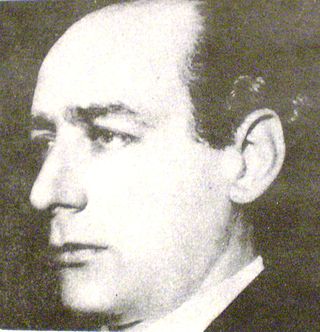
Cinema of Argentina refers to the film industry based in Argentina. The Argentine cinema comprises the art of film and creative movies made within the nation of Argentina or by Argentine filmmakers abroad.

Julio Irigoyen was an Argentine film director.
Palomas rubias is a 1920 Argentine romantic comedy film directed and written by José A. Ferreyra with Leopoldo Torres Ríos. The film premiered in Argentina on 18 August 1920.
Leopoldo Torres Ríos was an Argentine film director and screenwriter. His brother Carlos Torres Ríos was a notable cinematographer. His son was the film director and screenwriter Leopoldo Torre Nilsson.
La Gaucha is a 1920 Argentine silent film directed and written by José A. Ferreyra with Leopoldo Torres Ríos. The film premiered in Argentina on 27 April 1920.
Buenos Aires, ciudad de ensueño is a 1922 Argentine musical film directed and written by José A. Ferreyra. The film premiered in Argentina on 26 September 1922.

Laura Ana "Tita" Merello was an Argentine film actress, tango dancer and singer of the Golden Age of Argentine Cinema (1940–1960). In her 6 decades in Argentine entertainment, at the time of her death, she had filmed over thirty movies, premiered twenty plays, had nine television appearances, completed three radio series and had had countless appearances in print media. She was one of the singers who emerged in the 1920s along with Azucena Maizani, Libertad Lamarque, Ada Falcón, and Rosita Quiroga, who created the female voices of tango. She was primarily remembered for the songs "Se dice de mí" and "La milonga y yo".
Carlos Torres Ríos (1898–1956) was an Argentine cinematographer, film director, screenwriter, film editor and film producer of the classic era.

Manuel Romeo was an Argentine film director, screenwriter, dramatist and score composer, and one of the influential directors in the cinema of Argentina of the classic era. He directed and wrote over 50 films between 1931 and 1951 even composing the musical scores for several.

Roque Funes was the most prolific Argentine cinematographer in the history of the Cinema of Argentina whose career spanned over 40 years of cinema.

Perdón, viejita is a 1927 silent Argentine film directed and written by José A. Ferreyra. Ferreyra was born on 28 August 1889 in Buenos Aires, Argentina. He was a director and writer also known for Bewitching Kisses (1937) and La vuelta al Bulín (1926). Ferreyra died on 29 January 1943, at age 53. A fragment (34-minutes) of the film is currently available on YouTube. The restored version will be presented in the San Isidro Film and Music Festival on 15 November. 2016. The nitrate copy of the film was provided by the Fundación Cinemateca Argentina and the restoration work was done by GOTIKA,

Elías Isaac Alippi was an Argentine actor, theatrical impresario, film director and theater director, who was born and died in Buenos Aires. He is also remembered as an excellent tango dancer.

Olinda Bozán was an Argentine film actress and comedian of the Golden Age of Argentine Cinema (1940–1960). Born into a circus family, she acted on the vaudeville circuit, and performed in silent and sound movies. She was trained by the Podestá brothers, one of whom she married, who have one of the most prestigious Argentine acting awards named for them. Bozán' appeared in 75 films and was considered one of the best comic actors of Argentine cinema in the 20th century.

Lumiton is a former film production company and current museum located in Munro, Buenos Aires, Argentina. Lumiton Studios was founded in 1932 at the start of the golden age of film in that country. Its lowbrow, populist films appealed to local audiences and were highly successful in Argentina and throughout Latin America. It was the main competitor to Argentina Sono Film in the 1940s.

Amelia Mirel or Alma Bambú was the stage name of Amelia Ruggero, an early Argentine vedette, singer, and silent-film actress. After making approximately 20 movies, Mirel changed her stage name to Alma Bambú and began dancing in musical revues and burlesque theater.

Sabina Olmos (1913–1999) pseudonym of Rosa Herminia Gómez Ramos was an Argentine film actress of the Golden Age of Argentine Cinema (1940–1960).

Armando Discépolo (1887-1971) was an Argentine playwright. His most productive writing time spanned from 1910 to 1934 and thereafter, he produced theatrical performances of his plays. He is credited with creating and developing the Argentine version of grotesque literature known as Criollo Grotesque or Creole Grotesque, which is characterized by a mixture melodramatic tragic satire and domestic discord.

María Elena Lucena Arcuri was an Argentine film actress of the Golden Age of Argentine Cinema (1940–60). She began her career in radio in the 1930s and reached her greatest success with the role of "Chimbela", which was later depicted in film, theater and television. Her extensive film career includes approximately 50 films, including notable performances in Chimbela (1939) and Una noche cualquiera (1951). During the 1940s, she participated in films with comedians like Pepe Arias, Pepe Iglesias "El Zorro", Niní Gambier, Mirtha Legrand and Carlos Estrada. Her most acclaimed film work occurred in Elvira Fernández, vendedora de tienda (1942) by Manuel Romero, Cinco besos by Luis Saslavsky and La Rubia Mireya for which she received the 1948 Best Comedy Actress Award from the Argentine Film Critics Association.
Aurelia Del Carmen Guarini is an Argentine anthropologist, teacher, film director, and film producer specializing in anthropological documentary films. She teaches visual anthropology and directs documentaries in Argentina and in Cuba. She serves on the documentary projects' evaluation committee at the National Institute of Cinema and Audiovisual Arts and participates in Cine Ojo projects.
Benjamín Alfonso Tagle Lara was an Argentine lyricist and composer of tangos who achieved popularity in the 1920s.












